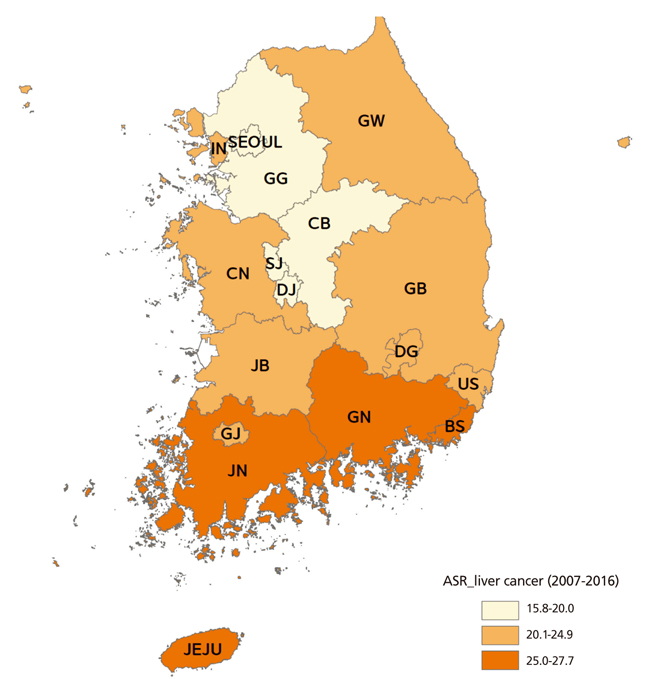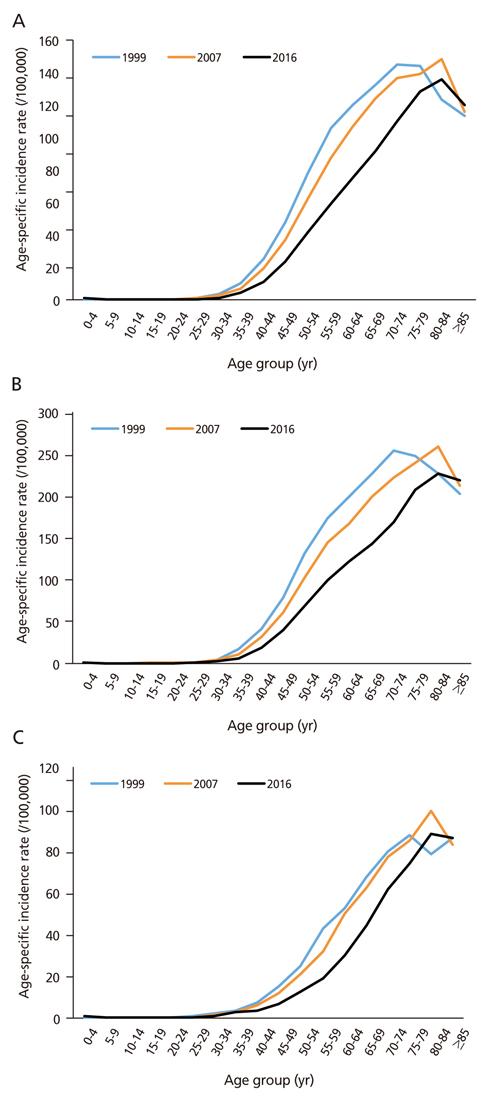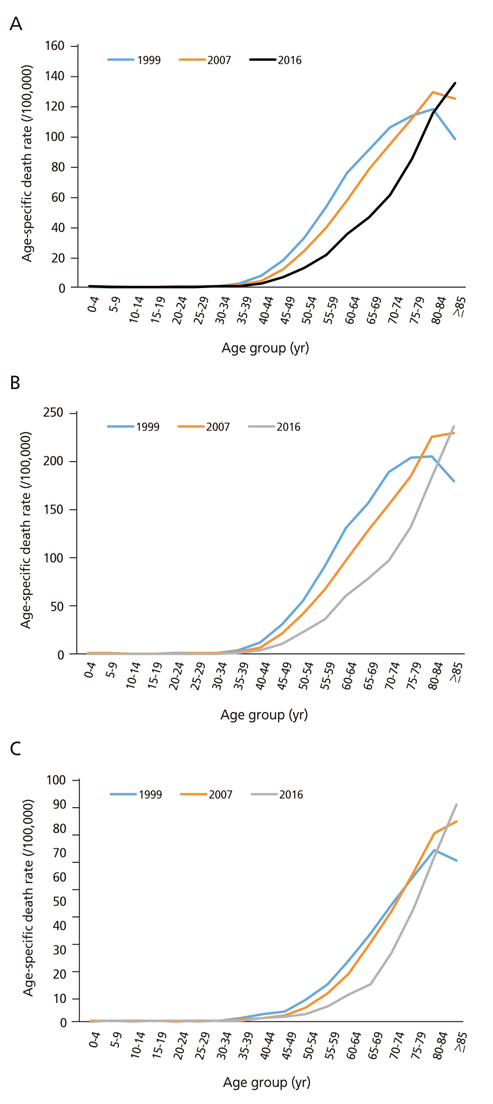J Korean Med Assoc.
2019 Aug;62(8):416-423. 10.5124/jkma.2019.62.8.416.
Epidemiology of liver cancer in Korea
- Affiliations
-
- 1Department of Preventive Medicine, Chonnam National University Medical School, Gwangju, Korea. ujingogo@paran.com
- KMID: 2455378
- DOI: http://doi.org/10.5124/jkma.2019.62.8.416
Abstract
- The incidence rate of primary liver cancer in Korea, the majority of which is hepatocellular carcinoma, has been decreasing steadily since 1999. However, Korea still has one of the highest incidence rates of liver cancer worldwide. Currently, liver cancer is the fifth most common cancer type in men and sixth in women. A total of 15,771 cases (11,774 men and 3,997 women) were identified, with an age-standardized incidence rate of 18.0 persons per 100,000 (29.2 in men and 7.9 in women) in 2016. Mortality from liver cancer has also decreased since 2002 in both sexes, although it is still the second most common cause of cancer deaths with 10,721 deaths (7,982 in men and 2,739 in women) in 2017. The 5-year relative survival rate was 13.2% in those diagnosed in 1996-2000, and it increased to 34.3% in those diagnosed in 2012-2016. Hepatitis B (HBV) and C (HCV) viruses are the most important causes of liver cancer, accounting for approximately 70% and 10% of liver cancer cases, respectively. Recently, the seroprevalence of HBV has markedly decreased to less than 3%, and the HCV antibody positivity rate has been estimated as about 0.7% in a nationwide survey. The participation rate of patients with hepatitis in liver cancer screening, a part of the National Cancer Screening Program, was still low at about 60% in 2018. Recent advances in the treatment of HBV and HCV could further reduce the burden of liver cancer despite its limited accessibility.
Keyword
MeSH Terms
Figure
Reference
-
1. Kweon SS. Updates on cancer epidemiology in Korea, 2018. Chonnam Med J. 2018; 54:90–100.
Article2. Statistics Korea. Annual report on the causes of death statistics 2017. Daejeon: Statistics Korea;2018.3. National Cancer Center. Korea Central Cancer Registry. Annual report of cancer statistics in Korea in 2016. Goyang: National Cancer Center;2018.4. Bray F, Ferlay J, Soerjomataram I, Siegel RL, Torre LA, Jemal A. Global cancer statistics 2018: GLOBOCAN estimates of incidence and mortality worldwide for 36 cancers in 185 countries. CA Cancer J Clin. 2018; 68:394–424.
Article5. Jung KW, Won YJ, Kong HJ, Lee ES. Prediction of cancer incidence and mortality in Korea, 2019. Cancer Res Treat. 2019; 51:431–437.
Article6. Suh M, Song S, Cho HN, Park B, Jun JK, Choi E, Kim Y, Choi KS. Trends in participation rates for the National Cancer Screening Program in Korea, 2002-2012. Cancer Res Treat. 2017; 49:798–806.
Article7. Ahn HR, Cho SB, Chung IJ, Kweon SS. Socioeconomic differences in self- and family awareness of viral hepatitis status among carriers of hepatitis B or C in rural Korea. Am J Infect Control. 2018; 46:328–332.
Article8. Shin A, Cho ER, Kim J, Sung J, Park KW, Lim MK, Shin HR. Factors associated with awareness of infection status among chronic hepatitis B and C carriers in Korea. Cancer Epidemiol Biomarkers Prev. 2009; 18:1894–1898.
Article9. McGlynn KA, Petrick JL, London WT. Global epidemiology of hepatocellular carcinoma: an emphasis on demographic and regional variability. Clin Liver Dis. 2015; 19:223–238.10. Choi J, Han S, Kim N, Lim YS. Increasing burden of liver cancer despite extensive use of antiviral agents in a hepatitis B virus-endemic population. Hepatology. 2017; 66:1454–1463.
Article11. Su TH, Tseng TC, Kao JH. HCC risk in patients with HBV-related cirrhosis receiving nucleos(t)ide analogues therapy: is HCC prevented or delayed. Hepatology. 2018; 67:1634–1635.
Article12. Zeng H, Zheng R, Guo Y, Zhang S, Zou X, Wang N, Zhang L, Tang J, Chen J, Wei K, Huang S, Wang J, Yu L, Zhao D, Song G, Chen J, Shen Y, Yang X, Gu X, Jin F, Li Q, Li Y, Ge H, Zhu F, Dong J, Guo G, Wu M, Du L, Sun X, He Y, Coleman MP, Baade P, Chen W, Yu XQ. Cancer survival in China, 2003-2005: a population-based study. Int J Cancer. 2015; 136:1921–1930.
Article13. Noone AM, Howlader N, Krapcho M, Miller D, Brest A, Yu M, Ruhl J, Z. T, Mariotto A, Lewis DR, Chen HS, Feuer EJ, Cronin KA. SEER Cancer Statistics Review, 1975-2015. Bethesda: National Cancer Institute;2018.14. Canadian Cancer Statistics Advisory Committee. Canadian cancer statistics 2018. Toronto: Canadian Cancer Society;2018.15. Broggio J. Cancer survival in England: national estimates for patients followed up to 2017. Newport: Office for National Statistics;2019.16. Foundation for Promotion of Cancer Research. Cancer statistics in Japan 2018. Tokyo: Foundation for Promotion of Cancer Research;2018.17. Kim BH, Lim YS, Kim EY, Kong HJ, Won YJ, Han S, Park S, Hwang JS. Temporal improvement in survival of patients with hepatocellular carcinoma in a hepatitis B virus-endemic population. J Gastroenterol Hepatol. 2018; 33:475–483.
Article18. Kim DY. New systemic therapies for advanced hepatocellular carcinoma. Korean J Gastroenterol. 2019; 73:10–15.
Article19. Yoon SK, Chun HG. Status of hepatocellular carcinoma in South Korea. Chin Clin Oncol. 2013; 2:39.20. Cho EJ, Kim SE, Suk KT, An J, Jeong SW, Chung WJ, Kim YJ. Current status and strategies for hepatitis B control in Korea. Clin Mol Hepatol. 2017; 23:205–211.
Article21. Korea Centers for Disease Control and Prevention. The Seventh Korea National Health and Nutrition Examination Survey (KNHANES VII). Cheongju: Korea Centers for Disease Control and Prevention;2018.22. Bae SH, Yoon SK, Jang JW, Kim CW, Nam SW, Choi JY, Kim BS, Park YM, Suzuki S, Sugauchi F, Mizokami M. Hepatitis B virus genotype C prevails among chronic carriers of the virus in Korea. J Korean Med Sci. 2005; 20:816–820.
Article23. Chung NS, Kwon OS, Park CH, Kim YN, Cho GH, Lee JJ, Kim GH, Kim HO, Ko KI, Yu SK, Kwon KA, Kim YS, Choi DJ, Kim JH. A comparative cross-sectional study of the development of hepatocellular carcinoma in patients with liver cirrhosis caused by hepatitis B virus, alcohol, or combination of hepatitis b virus and alcohol. Korean J Gastroenterol. 2007; 49:369–375.24. Corrao G, Arico S. Independent and combined action of hepatitis C virus infection and alcohol consumption on the risk of symptomatic liver cirrhosis. Hepatology. 1998; 27:914–919.
Article25. Iida-Ueno A, Enomoto M, Tamori A, Kawada N. Hepatitis B virus infection and alcohol consumption. World J Gastroenterol. 2017; 23:2651–2659.
Article26. Kanwal F, Kramer JR, Mapakshi S, Natarajan Y, Chayanupatkul M, Richardson PA, Li L, Desiderio R, Thrift AP, Asch SM, Chu J, El-Serag HB. Risk of hepatocellular cancer in patients with non-alcoholic fatty liver disease. Gastroenterology. 2018; 155:1828–1837.
Article27. World Health Organization. Guidelines for the prevention, care and treatment of persons living with chronic hepatitis B infection. Geneva: World Health Organization;2015.28. Lee D, Shin HY, Park SM. Cost-effectiveness of antiviral prophylaxis during pregnancy for the prevention of perinatal hepatitis B infection in South Korea. Cost Eff Resour Alloc. 2018; 16:6.
Article
- Full Text Links
- Actions
-
Cited
- CITED
-
- Close
- Share
- Similar articles
-
- Epidemiology of Hepatocellular Carcinoma in Korea
- Epidemiology of liver cancer in South Korea
- Correspondence to editorial on “Global epidemiology of alcohol-related liver disease, liver cancer, and alcohol use disorder, 2000-2021”
- Cholangiocarcinoma: Current Knowledge and New Developments
- Burden of alcohol use disorder, alcohol-related liver disease, and alcohol-related liver cancer: Editorial on “Global epidemiology of alcohol-related liver disease, liver cancer, and alcohol use disorder, 2000–2021





